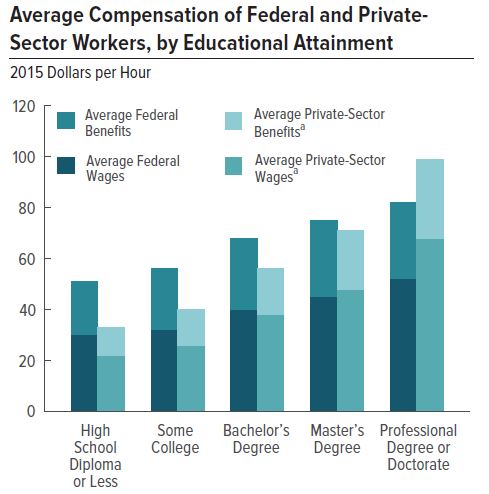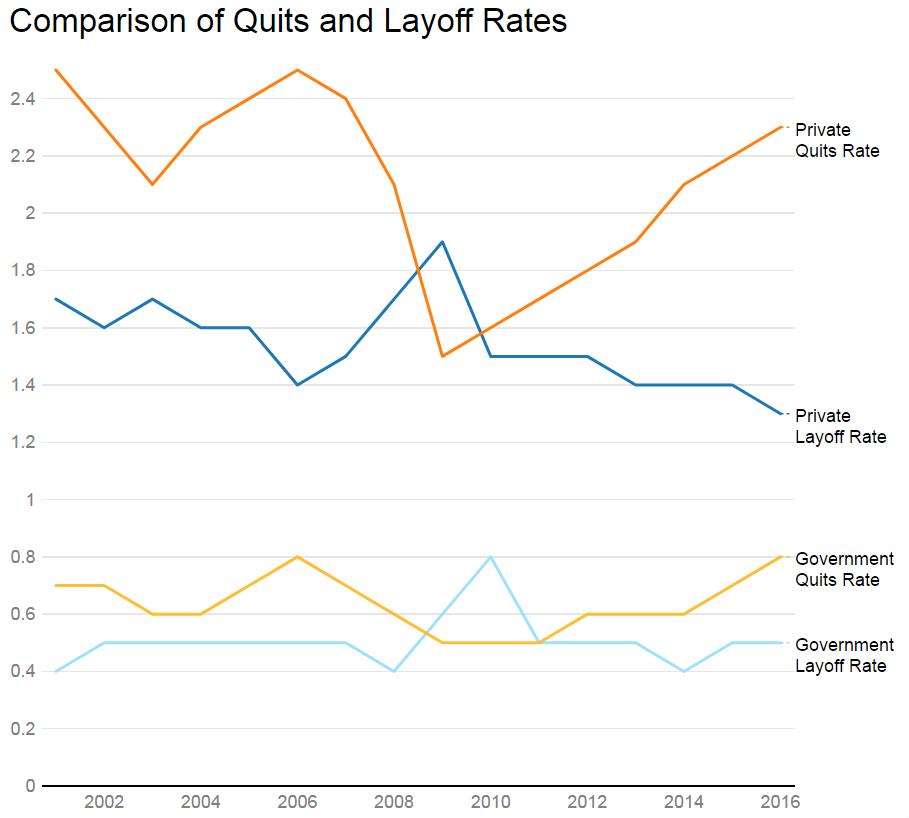One of President Trump’s goals is to reform the federal civilian workforce, some 2.2 million workers accounting for $215 billion in compensation last year. One challenge is measuring the productivity of individual government workers.
As with any group of people, some work hard and excel, while others muddle through each workday. Part of the problem with the current structure is that the framework for evaluating government workers does not seem to be effective, and inefficient workers can remain in place for years on end.
Part of the problem, as illustrated by a report from the Government Accountability Office, is that employee review and rating systems no longer transmit meaningful information about employee performance. Among the almost 1.2 million permanent employees included in the analysis, only 0.1 percent were deemed “unacceptable,” and 0.3 percent were “minimally successful.” The vast majority of these employees were rated as “outstanding” or “exceed[ing] fully successful.” Without question, there are hard-working, talented government employees throughout the federal workforce, but it stretches belief that there are virtually no ineffective ones.

Source: Government Accountability Office, “Federal Workforce: Distribution of Performance Ratings Across the Federal Government, 2013,” May 2016.
The lack of meaningful feedback about employee performance weakens the link between that performance and compensation or job security. Higher average compensation for federal employees exacerbates this problem, as lower-performing workers would be incentivized to remain in their positions if they are getting compensated more than they would in the private sector.
According to a recent report from the Congressional Budget Office, the federal government paid 17 percent more in combined wages and benefits “than it would have if average compensation had been comparable with that in the private sector, after accounting for certain observable characteristics of workers.” The comparison differs by the level of worker education: workers with a high school diploma or less averaged 53 percent more, while at the other end of the spectrum government workers with a professional degree or doctorate were compensated 18 percent less.
Even this might underestimate the true difference. Andrew Biggs at the American Enterprise Institute, posits that if the CBO used better measures for the wage differential or measured the value of federal benefits more similarly to how corporate pension liabilities, the average compensation premium for federal workers would be even higher.

Source: Congressional Budget Office, “Comparing the Compensation of Federal and Private-Sector Employees, 2011 to 2015,” April 2017.
Work environment, stability, and opportunity for advancement are an additional part of the total compensation package and are undoubtedly valuable. Looking at how the movement of government workers, both from voluntary quits and layoffs, compares to the private sector could shed some light on the differences between the two. Government workers are less likely to quit or be laid off than private sector workers, resulting in a workforce that is more ossified and stagnant.
Aside from the one-time spike related to temporary Census workers, the layoff rate for government workers is substantially lower than their private sector counterparts. Since 2003 the layoff rate in the private sector has averaged 1.5, triple the rate of layoffs and discharges for government workers. Very few government workers are let go due to rules surrounding dismissals and the lack of economic incentives to remove them. A supervisor who wants to get rid of an ineffective worker faces substantial bureaucratic hurdles and risk of a lawsuit from a government union.
Similarly, fewer government workers voluntarily leave their job to move on to another opportunity. The quit rate for private sector workers is around three times higher than the rate for government workers each year.
While both of these rates for private sector workers respond to the broader economic environment, they are much more stable for government workers.
These differences in these rates convey that in aggregate government workers are overcompensated and also enjoy a job security premium over workers in the private sector.

Source: U.S. Bureau of Labor Statistics, “Job Openings and Labor Turnover: Layoffs and Discharges.”
Government workers remain in their positions more than those at private companies. The lack of churn could be related to higher average compensation for public work, although there is a lot of variation depending on the level of education. The current federal workforce has room to improve when it comes to evaluating worker performance, and the link between performance and compensation should be strengthened. Government workers who are not good at their jobs should not keep them indefinitely, it is a waste of resources and the performance suffers.
Benefits for government workers that exceed their private sector counterparts could exacerbate the lack of feedback or consequences for poorly performing government workers, or incentivize some less productive workers to remain in government work indefinitely, reducing the efficiency of the government workforce.
Changes to the structure and composition of the government workforce should consider individual worker performances and opportunities to streamline duplicative or inefficient roles. At the same time, benefits and compensation should be reformed to reduce discrepancies between compensation for government and the private sector, while accounting for other factors such as higher stability in government work. The current administration will find many opportunities for improvement.
Charles Hughes is a policy analyst at the Manhattan Institute. Follow him on twitter @CharlesHHughes.
Interested in real economic insights? Want to stay ahead of the competition? Each weekday morning, E21 delivers a short email that includes E21 exclusive commentaries and the latest market news and updates from Washington. Sign up for the E21 Morning Ebrief.
Photo from iStock
